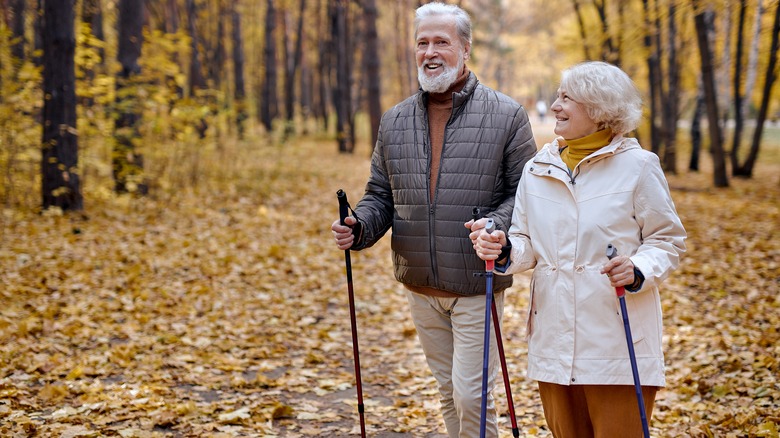Everything You Wanted To Know About Nordic Walking
Walking is hands down one of the most convenient forms of exercise. Almost anyone can do it and it's extremely versatile. From taking a leisurely stroll around your neighborhood to fast walking, or adding some weights to perform a farmer's walk, the variations seem endless. It probably comes as no surprise then that a new fitness trend has emerged. Let's give a warm welcome to Nordic walking.
Picture cross-country skiing (perhaps somewhere in the Nordic region) with two poles to help propel you forward along a snowy trail, now mimic that motion on your next walk at home (regardless of the season) — that's Nordic walking, shares Harvard Health Publishing. While it was meant as a training regimen for cross-country skiers in the summer, this low-impact cardio workout is trending in the U.S. (via Harvard Health Publishing). And, for good reason too! Not only do you get the benefits of walking, but the poles support the body when walking on bumpy or hilly terrain and they challenge the muscles promoting more fitness benefits. Plus, it's also easy to adjust the intensity level to match the needs of the walker.
But, what's most impressive is its ability to improve cardiovascular and mental health according to a recent study published in the Canadian Journal of Cardiology. In fact, the researchers reported that Nordic walking is more effective than high-intensity training (HIT) and moderate-to-vigorous intensity continuous training (MICT) at increasing heart health and lowering depression symptoms.
Nordic walking is better than regular walking
Believe it or not, Nordic walking even outperforms some of the benefits of regular walking. Brisk walking is a great aerobic exercise that reduces stress, enhances the immune system, increases cardiovascular strength, and improves balance, mood, sleep, and coordination, points out Mayo Clinic. It also strengthens the bones and muscles. But, Nordic walking takes fast walking to the next level.
Just by adding these special poles, this low-impact cardiovascular workout starts to vigorously target the arms, legs, core, and shoulders, says Harvard Health Publishing. In other words, Nordic walking is a great upper body and core workout. "When you get the poles involved, you really move; up to 80 to 90% of the major muscle groups are engaged, so you're just getting a better workout," explains Dr. Aaron Baggish, the director of the Cardiovascular Performance Program at Massachusetts General Hospital (via Today).
In addition, researchers from a 2019 study report that Nordic walking can also build shoulder strength and increase non-dominant hand grip strength, better than fast-paced walking. This is extremely important because the strength of your hand grip and shoulder translates to many everyday tasks such as grabbing a bag of groceries from the floor to opening a door. That being said, if you're wanting to build muscle while walking, using specialized poles may do just the trick.
Nordic walking helps you lose weight
On the other hand, if you're looking for a walking workout to burn fat and lose weight, Nordic walking may be the golden ticket. Why? The more muscles you recruit, the more calories you burn, shares Today. This is because you burn more calories per distance or time interval when you incorporate the upper body and that calorie expenditure increases by 40 to 50%, Dr. Baggish tells Today. To put it another way, this calorie expenditure is greater than brisk walking.
One 2019 study published in Clinical Interventions in Aging examined how Nordic walking and regular walking impacted weight loss in overweight people. What the researchers found was that Nordic walking was the all-around winner when it came to lowering body mass index and waist circumference. By the end of the study, participants who engaged in Nordic walking decreased body mass index by 6% and waist circumference by 8%. Whereas regular walkers only decreased by 4% for each respective category. But what's even more impressive is that the Nordic walking group also reduced leg fat, android fat, and total body fat.
Caution: Nordic walking is not magic. In order to lose weight it's important to follow a healthy diet filled with plenty of fruits, veggies, proteins, fats, and high-fiber foods, points out Healthline. Drink plenty of water, get quality sleep, and try to lower your stress levels. Remember to stay encouraged as weight loss takes time and soon enough the results will show.


